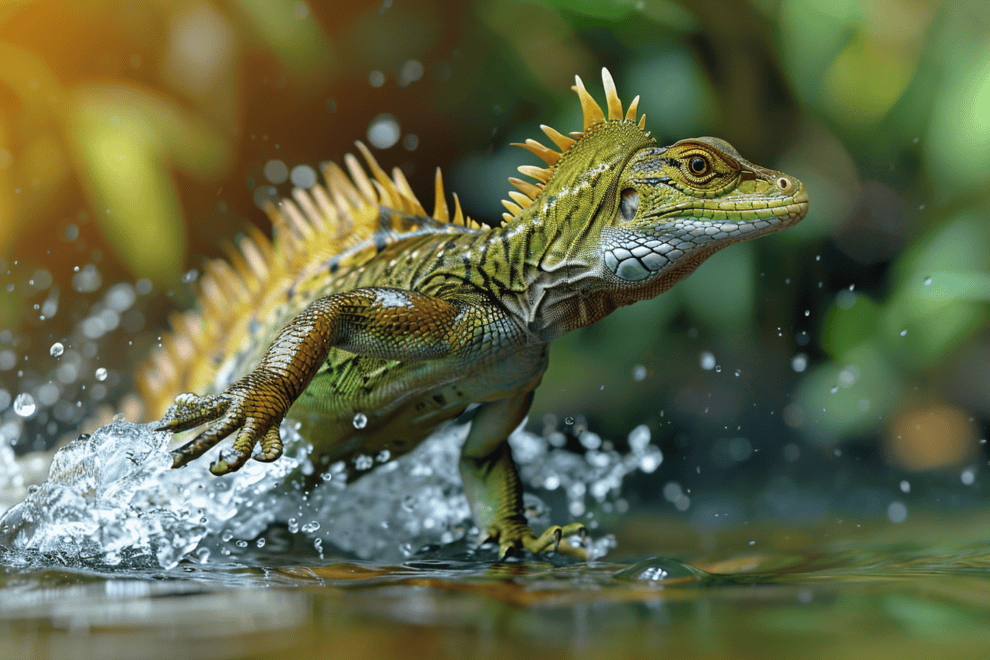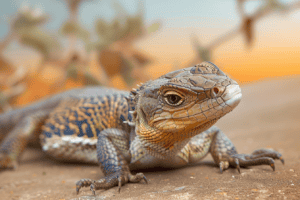Basilisk lizards are known for their incredible ability to run on water. These small reptiles, also known as Jesus lizards, have fascinated scientists and reptile lovers for centuries.
When it comes to water, the molecules are attracted to each other, creating a sort of “skin” on the surface. This is what allows insects to walk on water, and it is also what enables the basilisk lizard to run on water.

When the basilisk lizard runs on water, it uses a combination of speed, agility, and specialized anatomical adaptations. The lizards are able to generate sufficient lift and thrust forces to counteract their body weight and maintain an upright posture while running.
Scientists have been studying the basilisk lizard’s running ability for years, and they have discovered some fascinating facts.
For example, younger basilisks can run up to 10-20 meters on water, while adult lizards can only cross a few meters before sinking.
Additionally, when moving quickly, the lizard can cross a surface of water before sinking. On water, it runs at an average speed of 24.1 km/h (15 mph), which is just a little slower than its speed on land.
These statistics and facts provide insight into the incredible abilities of these tiny creatures and their unique adaptations to their environment.
The Wonders of Basilisk Lizards
Basilisk lizards are exceptional creatures that have captured the imagination of many people. These lizards are known for their remarkable ability to run on water, a feat that is nothing short of miraculous.
In this section, we will explore the wonders of basilisk lizards and how they are able to defy gravity and run on water.
Defying Gravity with Speed and Agility
Basilisk lizards are fast runners, and they owe their speed to their powerful hind legs. These legs are specially adapted to provide the necessary force to propel the lizard forward.
When running on water, the basilisk lizard uses a combination of speed and agility to stay afloat.
The lizard moves its legs in a rapid motion, creating pockets of air that help it stay on the surface of the water.
This is made possible by the lizard’s unique feet, which we will explore in the next subsection.
The basilisk lizard’s speed is truly impressive.
These lizards can run at speeds of up to 8 miles per hour on land, and up to 5 miles per hour on water. This makes them one of the fastest lizards in the world.
The lizard’s ability to run on water is not just a party trick, it is a survival mechanism. When threatened by predators, the lizard can quickly escape by running on water, which is a difficult surface for most predators to navigate.
A Close-Up on the Basilisk’s Unique Feet
The basilisk lizard’s feet are specially adapted to provide the necessary grip and surface area for the lizard to run on water.
The back feet of the lizard can spread out like paddles, maximizing the amount of surface area in contact with the water. This allows the lizard to stay afloat and move forward with ease.
The secret to the basilisk lizard’s ability to run on water lies in surface tension.
Surface tension is the force that holds the molecules of a liquid together. In the case of water, the molecules are attracted to each other, creating a sort of “skin” on the surface. This is what allows insects to walk on water, and it is also what enables the basilisk lizard to run on water.
The lizard’s feet create a small indentation on the surface of the water, which breaks the surface tension and creates a pocket of air. This pocket of air helps the lizard stay afloat and move forward.
Survival Tactics in the Wild

One of the most impressive survival tactics of the basilisk lizard is its ability to walk on water. This skill allows it to escape from predators such as birds, snakes, and other animals that might attack it on land.
When threatened, the basilisk lizard can run across the surface of the water at an incredible speed of up to 5 feet per second. It does this by slapping its feet on the water, creating air pockets that keep it afloat.
Basilisk lizards are found in the rainforests of Central and South America, where they live near rivers and lakes. They are excellent swimmers and can dive up to 30 minutes to find food.
Their diet consists of insects, small fish, and other aquatic animals. Basilisk lizards are also known to eat fruits and flowers.
These lizards are well adapted to their natural habitat.
They have long toes with sharp claws that help them climb trees and grasp onto branches. Their green coloration allows them to blend in with the foliage, making them difficult to spot by predators.
The basilisk lizard is also able to regulate its body temperature by basking in the sun or seeking shade when it gets too hot.
The Mechanics of Water Running

Basilisk lizards are known for their ability to run on water, a feat that seems to defy gravity. But how do they do it? The answer lies in the physics of surface tension and the biology of legged locomotion.
When a basilisk lizard runs on water, it creates a series of waves that help it stay afloat. The lizard’s back feet act like paddles, maximizing the amount of surface area in contact with the water. This increases the amount of force the lizard can generate, allowing it to push against the water and stay on top.
But that’s not all.
The lizard’s center of mass is positioned in such a way that it creates a region of stability, allowing the lizard to maintain its balance while running on water. This is known as static stability, and it’s an important concept in the mechanics of legged locomotion.
Adaptations and Evolution: The Basilisk’s Journey
The basilisk lizard’s ability to run on water is not just a random quirk of nature. It’s the result of millions of years of evolution and adaptation.
Over time, basilisk lizards have developed a number of specialized adaptations that allow them to run on water with incredible speed and efficiency.
For example, their long toes help to distribute their weight more evenly, reducing the pressure on any one point and increasing their buoyancy.
But perhaps the most important adaptation is their ability to adjust their gait to match the surface they’re running on. This allows them to maintain their speed and stability even on uneven or unpredictable surfaces.
All of these adaptations and strategies have helped basilisk lizards become some of the most skilled runners in the animal kingdom. They are a true marvel of science and evolution, and their ability to run on water is just one example of the incredible diversity and ingenuity of the natural world.
Fun Fact: Basilisk lizards are also known as “Jesus lizards” because of their ability to run on water, a reference to the biblical story of Jesus walking on water.
Frequently Asked Questions

What special adaptations do basilisk lizards have that allow them to move across water surfaces?
Basilisk lizards have several unique adaptations that enable them to run on water.
One of the most crucial adaptations is their large, webbed feet that act like flippers, providing them with a larger surface area to support their weight on the water.
Additionally, they have long toes that are capable of spreading out, allowing them to disperse their weight and prevent sinking.
Basilisk lizards also have a unique gait, where they rapidly slap their feet on the water surface, creating air pockets that help them stay afloat.
Can you explain the science behind a basilisk lizard’s ability to avoid sinking when it runs on water?
When a basilisk lizard runs on water, it uses a combination of speed, agility, and specialized anatomical adaptations.
Basilisk lizards have the ability to create pockets of air by slapping their feet on the water surface, which helps them stay afloat and avoid sinking.
Additionally, their large, webbed feet and long toes provide them with a larger surface area to support their weight on the water.
How does the speed of a basilisk lizard on water compare to its speed on land?
Basilisk lizards can run on water at an impressive speed of up to 5 feet per second, which is about 4.5 miles per hour.
This is approximately the same speed as they can run on land, making them one of the fastest lizards in the world. However, they can only maintain their speed on water for short distances before sinking.
Is there a limit to the distance a basilisk lizard can cover while running on water?
Yes, there is a limit to the distance a basilisk lizard can cover while running on water.
Basilisk lizards can only run on water for short distances before sinking, usually between 10 and 20 meters. Once they start to slow down, they quickly sink below the surface and must swim to safety.
What factors influence a basilisk lizard’s capacity to run on water?
Several factors influence a basilisk lizard’s capacity to run on water, including their size, weight, and speed.
Smaller lizards are generally better at running on water than larger ones, and lighter lizards can stay afloat for longer periods. Additionally, basilisk lizards that run faster are more likely to stay on the surface of the water.
Are there any other animals that share the basilisk lizard’s water-running ability?
Basilisk lizards are not the only animals that can run on water. Other animals that share this ability include certain species of birds, such as the common moorhen and the American coot, as well as some insects like water striders.
However, basilisk lizards are unique in their ability to run on water using a combination of speed, agility, and specialized anatomical adaptations.









